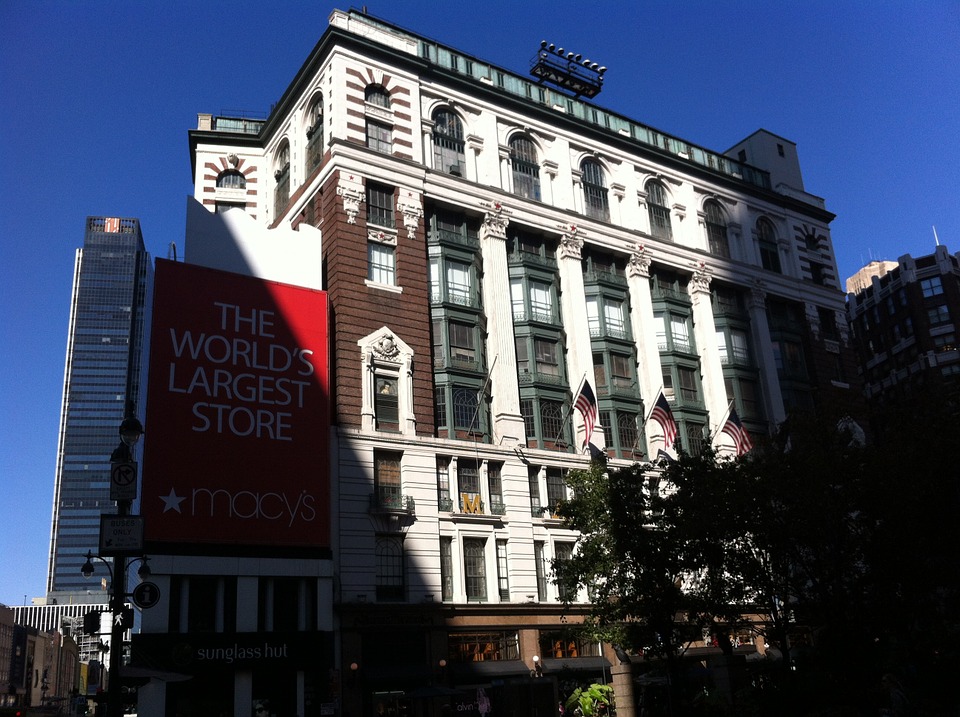On a cool April morning in 1878, a headline in the New York Times proclaimed “The Great Sixth-Avenue Bazaar.; Opening Day at Macy & Co.’s – A Place Where Almost Anything May Be Bought.” What was most unique and original about this new store, the article noted, was the “universality of the stock, almost every article of dress and household furniture being for sale there, and at the most reasonable prices.” By 1924, the store had doubled its building size and held its first holiday parade called “Fairyfolk Frolics in Wondertown.” And by the end of the 1920s, Macy’s had become the country’s largest department store.
Macy’s, Hudson’s, and Marshall Field, the three biggest American department store chains by the 1960s, became core institutions which reassured citizens that life was good, that stability, organization, and order prevailed, and that beauty was important. To the average middle-class family, they were a one-stop shop. Not only did these stores sell a wide array of items in one place, they hosted displays, demonstrations, lectures, and entertainment spectacles. They defined a way of life.
And for a number of years, the one-stop shop approach seemed to connect. It seemed to deliver.
Until it didn’t.
News agencies and economists are calling the current transformation of the retail industry “The Great American Department Store Shakeout.” But Macy’s and other once-popular department stores began to decline in the late 90s and early 2000s. The once-appealing one-stop shop approach is no longer as effective as it once was. In previous years, department store chains attempted mergers and take-overs (think Sears and K-mart) to appear as if they were at least stabilizing. But preservation-focused decision-making contributed to an even sharper decline. It was as if the one-stop shop approach had created an in-house bottleneck as these companies tried to work harder at the only activities they had the imagination to do: turning over new products (including those endorsed by famous people) and investing in advertising. Soon, cavernous buildings that used to be bustling with crowds closed or became eerily empty on weekends. Outdated shoes in the shoe department were spotted to be accumulating dust, while tiles began falling off the walls of the bathrooms.
What the Church Can Learn
You may have already drawn mental parallels between the story of the department store and that of the 20th century American mid-sized church. In the latter part of the century, mid-sized churches became a “one stop shop” for Christians and supposedly for what the Christian life entailed. Churches grew departments—children, youth, discipleship, worship, and missions—which were organized and often housed in the interior of huge, ornate (traditional or modern) buildings. Worship and preaching were conducted by professionals. Financial giving supported the programs of the church. Believers attended Bible classes before or after worship or during the week. Kids and youth could be dropped off to their own departments.
Mission and service became a plea from the pulpit for new children’s ministry workers or a sign-up to give money or pay money to go paint a church in a foreign country for a week, while evangelism became about telling your friends how to escape hell or about inviting them to church—or both. Christian maturity was exemplified by attending church once a week, attending a class or group once a week, giving once a week, and serving at the church once a week.
But perhaps this very structure is actually what becomes detrimental to the long-term discipleship, growth, and everyday mission of a congregation. It can stunt initiatives to reach out and start new things. Here are three reasons why:
A One-Stop Shop Restricts Behavior.
Those of us who remember our parents taking us to buy shoes at the department store remember having to find something we liked. Mom or dad wasn’t taking us anywhere else, so you were stuck with the brands they carried (and hopefully they had your size). The good news was that in five minutes, you could also buy tools or pants or toys, within the limits of the options the store chose for you.
In a similar way, fitting in to a local church often means fitting in to one of the programs or ministries or serving needs offered by the church. Once you become a Christian or transfer your membership, the majority of your energy and expectations are fulfilled in the building. Potentially, you can get all of your Christian needs and expectations met on a Sunday morning. And if the church doesn’t supply it or you missed the sign-up, you have to wait until the next time around.
But a church that is a one-stop shop reinforces the false idea that Christian life and ministry is restricted in time, place, and form. It invalidates that ministry can and should be done outside church programming and organization. If someone is not interested in or doesn’t fit into the serving needs of the church (hospitality, anyone?), he is not encouraged to start something that could minister to others through their giftedness. If someone is strategically placed (by God) to have an impact on a certain community, she may still be told she needs to connect to a small group at the church to fulfill her membership. Over time, the one-stop shop limits creative behavior and expansion into new frontiers in the community. People grow accustomed to ministry happening in the church at specific times, organized by specific people. It turns potential leaders into pew-sitters and consumers rather than legitimizing their ministry and call outside the church walls.
A church that is a one-stop shop reinforces the false idea that Christian life and ministry is restricted in time, place, and form. It invalidates that ministry can and should be done outside church programming and organization.
Tweet this.
Consumers are Never Consistent.
Department stores’ sheer size and amazing inventory was a product of the times and of consumer preferences. Buying power showed social power. When competition arose, stores were in a race to show the public what they could offer, to prove they were the best. But when technology and consumer preferences changed, department stores were stuck in the structure that had gotten them to where they were. They attempted to compete for consumers, but consumers began out-changing the stores’ capacity and adaptability. The consumers who stayed did so out of loyalty, and not because they thought they could get the best products.
Church can easily become something for people to consume. Adapting to preferences in music, dress, communication style, and attractive programming are all necessary choices that churches need to make but often can put a church in a ring of competition for consumers, as well as nurturing their consumerist instincts. Instead of measuring transformation, discipleship, and sending capacity, a church becomes caught up in the roller coaster of weekend attendance. Instead of spending time training people to be missionaries to their own neighborhoods and communities, churches spend the most time (and money) on the weekend “show.” But consumers’ interests and habits are fickle. They leave when they no longer receive what they came for, and they never developed roots. The danger of chasing after consumers is that you will always be chasing after them.
The danger of chasing after church consumers is that you will always be chasing after them.
Tweet this.
Bigger is Not Necessarily Better.
At its peak in the 1960’s, Hudson’s department store spanned twenty-five stories, sixteen of which were selling floors. Two of the four floors were basement stores, where 60 departments were responsible for up to twenty-five percent of the store’s business. Hudson’s employed around 12,000 employees and welcomed 100,000 shoppers each day. Many other department stores in malls and cities across the country boasted thousands of square feet, multiple levels, and anything you could ever want. Bigger was thought to be better—until the buildings were empty.
The church growth movement followed suit, promoting bigger and bigger buildings with classrooms, play areas, and even cafés. But even megachurches like Willow Creek experienced a common problem—a wide-open back door. People have difficulty connecting in crowds and are less likely to continue in them—unless, of course, they can be involved in a smaller group of the community. Sociologists say that people best connect and tend to make lifelong friendships and relationships in smaller groups of under forty people. And contrary to popular belief, work teams are more fruitful with a handful of individuals rather than a roomful. With growth comes the need to “grow small” and create opportunities for people to connect and serve with their gifts, in the same manner as the early church which saw the movement of the Spirit among them as they assembled in homes, synagogues, and marketplaces within a city.
Final Questions to Consider
Is your church a one-stop shop? If so, how can you begin propelling people into ministry in their neighborhoods, workplaces, and communities instead of serving only church needs?
Do you focus on meeting [consumer] needs over fulfilling mission? If so, reallocate the amount of time, energy and money from “the show” towards training and propelling disciples into your local mission field.
Are you seeking to grow small? No matter your size, create smaller environments for holy encounters to happen and relationships to form.
(This article originally appeared at Missio Alliance)


